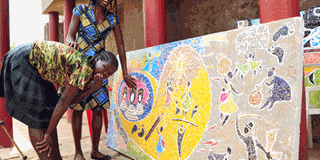Changing street lives using airtime cards

Alison Nadunga (standing) points at one of the art pieces done by one of her beneficiaries. PHOTOs by Micheal Kakumirizi
What you need to know:
Passionate. As most university students are busy partying during their free time, their colleague, Alison Nadungu is busy changing lives through art.
Collections of used airtime cards scattered on streets and in garbage have allowed Alison Nadungu to make fascinating mosaics relaying images of lives of the suffering Ugandans. Well, this might not be exceptional, but the therapeutic element embedded in her mosaic patterns is something extraordinary.
The 23-years-old, third year student of Bachelor of Health Sciences at International Health Science University at IHK, Kampala, hatched an idea of engaging street children into designing mosaics to ease the distress they face on streets. Unlike most university students who devote their leisure time to partying, Nadungu spends hers helping street children to overcome their challenges.
With the help of her Karimojong interpreter, James Egabu, she goes to the streets to persuade street children to join her project, dubbed “Repainting Uganda”.
“It is not easy to convince them. They think you are taking them to prison,” said Egabu, who helps Nadungu communicate with the street children. But when they manage to convince the first group, that group persuades others.
If there is something clear about these street children, it is their involvement in the project and their artistic skills.
They collect most of the airtime cards themselves - a sign of intrinsic values, and a bearing to their lives.
“It helps me acquire skills to improve my life,” says one of the beneficiaries, Maria Kokwoi, a 17-year-old mother of an eight months-old baby.
As one of the beneficiaries, she hopes the skills she acquires will help her make her own art pieces which she hopes to sell. The project currently comprises about 10 street children, and she hopes the number will increase with time.
Due to the trauma they go through on the streets, it is difficult to penetrate their hearts. To Nadungu, while many people think street children are difficult, none understands how they got be difficult. For her, the issue of why and how they got to be difficult is the one that should be addressed.
The work itself has loud messages. The art portrays their dreams; through themes such as education, better maternal health care, family support and union, and togetherness and social cohesion.
As a health science student, Nadungu has also done a few pieces on health issues such as sanitation, nutrition, and environment health that encourage hygiene. However, she has not sold any of the pieces so the project thrives entirely on her little pocket money, and the money she earns out of her small banana cake business (she sells to her classmates). Nadunga says she uses about Shs200,000 every month to buy the beneficiaries drinks (sodas) and other things. This is about Shs25,000 per meeting. They meet six or eight times a month, depending on her school timetable.
What inspired her?
After witnessing what street children go through, Nadungu decided to devise something that would not only provide them with skills, but also offer them therapeutic help.
“I was heartbroken by the lifestyle of street children. They live in poverty and struggle daily to get food, clothes and other basic needs. Yet some of these children do not get to understand how they got on the streets,” she says, recalling her first encounter with street children.
Nadungu says while some street children do it as a business, others are buried in the clouds of problems, and they are genuinely suffering. Some get beaten up by drug addicts in slums.
Currently, her priority group comprises of women with the intention of equipping them with skills so they can find an alternative source of income. They meet twice a week at Deliverance Church, Makerere Hill. When they take a break from work, she plays violin for them as they sing along.
Despite her zeal to help street children, Nadungu is faced with challenges of funding. Also, sometime she gets street children and they disappear the following day. Some of them get arrested and taken to Kampiringisa Rehabilitation Centre and other rehabilitation centres, then show up after sometime. For now, Nadungu hopes she can attract as many street children as she can and make an impact in their lives as she waits to realise her dream of starting a street children rehabilitation centre in future.
About the project
Started in January, 2013, “Repainting Uganda” is meant to help street children get an alternative source of income, as well as change in attitude towards street life. The project is a subsection of an organisation under a grand name “Milege band”, which also has an Afro-jazz band that aims at rejuvenating Uganda’s cultural heritage through music. It was started in 2010.
Psychologists’ take
Psychologists say mosaic is an important tool for distressed people to communicate their problems.
Steven Langa, a counsellor, and director of family life network says indeed art is an important tool in communicating problems and it can help street children to open up and ease pain. But Guston Byamugisha, a counselling psychologist at Uganda Christian University, adds, whereas art is an important tool in getting people to open up, there is need for a more therapeutic measure like counselling for them to heal fully.
Why used airtime cards
Used airtime scratch cards have an embedded connotation. They represent the lives of the street children. Like the way used airtime cards are littered on streets, so are their lives. “It is wasted materials to change lives of “wasted street children,” Nadungu says.
It is in these used airtime cards that the therapeutic element is ingrained. The use of used airtime cards signifies how their lives are perceived - useless, similar to littered airtime cards.
Her initiative aims at giving these street children tangible skills and therapeutic measures to deal with their social problems, pains, and disappointments. Picking up littered airtime cards is likened to picking up their lives and hopes.
“Many of them feel like life is a death sentence for them. Picking up broken pieces and putting them together is a message of hope to them. This helps them realise life is not entirely useless, that they can still pick up broken pieces together and make achievements. This is because they feel they are abandoned like the way used up airtime is,” she says.
How the scratch cards are used
Airtime is cut into small pieces and joined together using glue. Joining these pieces requires patience and commitment, which she says, connotes what is needed to rebuild their lives.
The remains are burnt into ash, which is also used to make the mosaic.
“This signifies that however much “burnt out” their lives, they can still achieve in life,” Nadungu says.
Each of them takes responsibility of collecting used airtime scratch cards.
What they say
‘It is not easy to convince them to join the project. They always think you want to take them to prison,’
James Egabu, translates aKarimojong into english for nadungu
‘The project helps me acquire skills to improve my life,’
Maria Kokwoi, beneficiary
‘I am happy because I get a soda whenever I come here. I also learn to make art pieces which will help me make money,’
Anna Amilo, beneficiary




